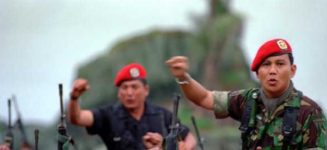The peace deal to be signed next week by the Indonesian government and the Acehnese rebel Free Aceh Movement GAM found its origins in painstaking lobbying initiated by then Coordinating Minister for People’s Welfare Jusuf Kalla and his aides in mid-2003.
A key figure was Deputy Coordinating Minister for People’s Welfare Farid Husain, a member of the Indonesian delegation, whose tireless efforts bore fruit as his path came across Finnish philanthropist Juha Christensen, who was connected to former president Martti Ahtisaari.
A few weeks before the tsunami, GAM leaders in Sweden agreed to meet. A month later, the peace talks started.
“Who … Juha? Juha Christensen? He’s my friend, he is the one who arranged this (dialog)” replied Farid enthusiastically when I met him last April at the Indonesian ambassador’s house in Helsinki.
Farid is an energetic man, and a joyful and easygoing person, who loves joking; but he can also be very serious.
Recently, at the Helsinki Hilton Hotel, he told Radio Netherlands the story of his mission, as assigned by his patron, fellow Buginese, Vice President Jusuf Kalla.
It was mid-2003: The war was already underway in Aceh following the collapse of the Cessation of Hostilities Agreement (CoHA). Yet, Jusuf Kalla believed there was a need to talk.
“We were exploring the possibilities of engaging in dialog,” said Farid, “It doesn’t matter how long (it would take). What is important is there should be a willingness to talk. In any conflict resolution, we have to believe that as long as there is a willingness, there should be good intentions and purpose.”
Farid loves the metaphor of family life. As with family problems, he believes, a dialog is necessary; so are brokers, sometimes.
Farid’s would-be brokers were Acehnese in Aceh and elsewhere in Indonesia and abroad. He patiently built relationships with close relatives of GAM leaders Malik Mahmud, Zaini Abdullah and others.
His first link was Mahyudin, a civil society activist. Soon, his mission took him to Malaysia, Singapore and European capitals.
Getting close to GAM
The job was far from easy. Being a government official, Farid was fully aware of the difficulties of meeting with GAM members. They needed consent from all groups to avoid suspicion. “No, no deal. I didn’t make any deal. I just came as a human being, trying to be close, familial and maintaining an emotional bond with them. I didn’t talk about business. As a medical doctor, I asked them about their health and things like that.”
“My mission,” Farid claimed, “was just humanitarian and I believed God blesses me. Hence, my main asset was to be sincere. I did so, too, in Poso and Ambon.”
Thus, Farid’s first network was GAM families and ringleaders. “They did not know about me before. Now they knew, here is Farid Husain, who assisted Pak Jusuf resolving the conflicts in Poso and Ambon. And I have the advantage of coming from the outer islands. I mean — you know — I’m not from Java.”
After several meetings, “the fifth visit or so”, Farid felt they knew that he had serious intentions. “I continued building trust and confidence, yet with no results.” His attempts to contact GAM leaders were to no avail.
2003 was a bad year. The war in Aceh went on, as did the crackdown. Half a year later, Farid’s lobbying efforts were at an impasse.
Meanwhile, a good friend in Sulawesi, Arifuddin Djuana, told Farid that his guest from Finland wanted to meet him. Juha Christensen, a shy but friendly linguist-turned-businessman from Lahti, had lived in South Sulawesi and did research on the Rampi language in the 1980s. Juha was interested in Aceh and had had meetings with GAM leaders in Stockholm.
Farid was clearly enthusiastic. “I knew Juha already. At the University of Hasanudin (Makassar), he was a researcher and I was a lecturer. He came to my office in Jakarta to inquire about selling speedboats. He congratulated me on peace in Poso and Ambon.”
Then, he talked about Aceh and said “I know people from GAM”.
I asked him, Can you give me some contacts? “OK, 100 percent!’” he replied.
For Juha, too, it was not easy to gain the trust of GAM leaders. As journalist Katri Merikallio revealed in the February edition of Suomen Kuvalehti, Juha only passed the ‘test’ as he was able to meet former GAM negotiators in prison in Bandung.
Later, he arranged a secret meeting between Kalla and GAM adviser Damien Kingsbury in Jakarta.
“But, Juha didn’t know the rules of the game,” said Farid, referring to his presumption that GAM members needed consent from their leadership before meeting Indonesian officials.
Subsequently, Juha and Farid, both separately and together, did some heavy-duty traveling to and from Indonesia, Europe and Scandinavia.
“About four or five times I tried to meet (GAM leaders); I even wandered around Norsborg (a Stockholm suburb where they resided), but in vain. I wondered, why? But I did meet and exchange information with their representative in Amsterdam, M. Fadlun, and his comrade from Denmark. That was early 2004.”
GAM leadership remained hesitant because of martial law. When the two lobbyists went to Stockholm, they were only willing to talk to Juha. Farid had to wait for four hours in the hotel lobby.
“They didn’t come to me and I didn’t go to them. They had not apparently acquired the consent of (top leader) Hasan di Tiro,” said Farid.
Approaching Martti Ahtisaari
They decided to take a new course. Juha’s idea was to approach Martti Ahtisaari, the chairman of an internationally respected non-governmental organization, the Crisis Management Initiative. On the same day, Juha’s friend, the chief editor of the newsweekly Suomen Kuvalehti contacted the former Finland president.
“We bought ticket to Helsinki,” said Farid, “We only had two-and-a-half hours. I was still wearing my blue jeans; Pak Ahtisaari didn’t mind. We talked about Aceh; I explained the special autonomy and the failure of CoHA. He listened carefully and asked many questions. He was wonderful, truly a diplomat!”
Meanwhile, in late 2004, the new administration of President Susilo Bambang Yudhoyono and Vice-President Jusuf Kalla came to power. For GAM, the picture became clearer.
Things have looked brighter since. Kalla decided to proceed and instructed Farid to stay close to GAM. “No, not a request, it’s an order! He ordered me to be a friend of GAM, a brother,” said Farid. “Juha arranged everything and I established contact between Ahtisaari and Pak Jusuf.”
As Ahtisaari agreed to ask questions, he met secretly with GAM leaders, who finally agreed to talk to the Indonesian government. Sometime in Dec. 2004, a meeting was planned. Just as an invitation was sent to Stockholm, the tsunami radically changed Aceh. “Of course, that’s also an important factor,” said Farid.
“As time went on, (GAM leaders) trusted us. The forum proved that we were serious. We listened to them. We also have a solid team,” Farid explained. Indeed, the five Indonesian team members, now nicknamed “All Wapres’ (VP’s) Men”, never changed and had a clear division of labor.
The final test for Farid Husain was to act as a troubleshooter to save what could be a historic deal. As the talks were almost deadlocked on July 15, he disappeared from the ambassador’s house where the delegates rested or chatted with journalists.
It turned out he had gone to the city to meet a GAM representative.
The next day, the parties had an accord.



